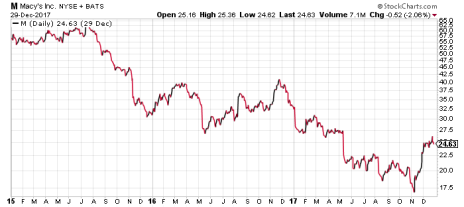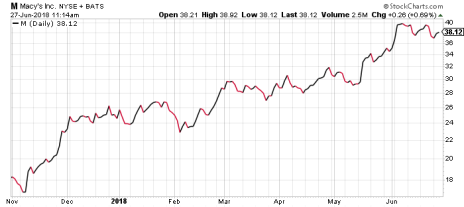General Electric (GE) looks like a dead stock. Since the beginning of 2017, GE stock has lost more than half its value, prompting the Dow Jones Industrial to boot its longest-tenured member from the exclusive index earlier this month. To many investors, that makes GE untouchable. To some, that makes it a dirt-cheap bargain stock. And before you laugh at that latter group, consider the case of Macy’s stock.
Entering this year, Macy’s had a three-year stock chart that looked like this:
Like GE, Macy’s stock had lost more than half its value—much more, in fact. From its August 2015 peak above 72, M plummeted to a low of 18 last October—a 75% drop-off in just over two years. Part of the decaying department-store industry, Macy’s seemed pretty hopeless—just the latest retail victim to be gobbled up and spit out by Amazon (AMZN). And Macy’s stock appeared toxic.
Since that October bottom for M stock, here’s what has happened:
Well, what do you know! Macy’s stock wasn’t dead after all!
M has not only more than doubled since that Halloween bottom, but has been one of the best-performing large-cap stocks on the market in 2018, up 50% year to date. How has Macy’s recovered? Well, back-to-back quarters of sales growth has helped—the first time that’s happened since 2015. Meanwhile, the company is quite profitable, as the plan to shutter 68 stores appears to be freeing up some cash.
[text_ad]
Meanwhile, the stock remains quite cheap even after rallying for eight months, with a price-to-earnings ratio of just 7, and a forward P/E of only 10. With earnings expected to keep growing, Macy’s still looks like a bargain.
Macy’s stock gives GE hope. It shows how quickly fortunes can change on Wall Street. And it’s why some investors like to “bottom-fish”—or perhaps deep value investing, if you’re being charitable.
And that brings me to what our Crista Huff, our value investing expert, wrote about General Electric recently, highlighting some of the company’s positives. Here’s what she said:
“While General Electric stock had become irrelevant to the Dow, the company is not a disaster, and is not losing money, although its debt obligations are forcing painful and regrettable business decisions. While focusing on its power, healthcare and aviation businesses, GE is selling off business units in order to raise money to fund pension liabilities and to maintain its quarterly dividend. GE also owns a majority stake in Baker Hughes (BHGE), a very profitable oilfield service company.”
Now, Crista doesn’t recommend buying GE stock. Charts are important to us here at Cabot. We don’t blindly bottom-fish just because a once-great stock has been knocked back to dirt-cheap levels. To regain our faith, GE will first need to prove itself.
If it can do that, it will most certainly end up on our radar. Macy’s stock is. Our Mike Cintolo recommended it to subscribers in the May 29 issue of his Cabot Top Ten Trader momentum-investing advisory. All M has done since is rise another 9%.
Long story short: don’t even think about buying GE stock right now. But don’t count it out either. As Macy’s showed us, declaring stocks dead is often premature.
[author_ad]




